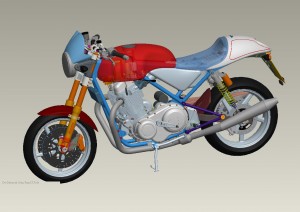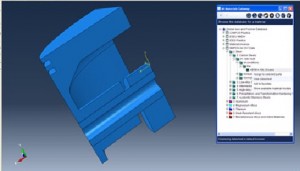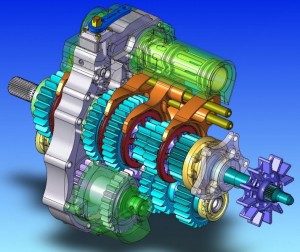A bike, which company wants to introduce in market, gets its specifications determined after completing market survey. This process is further extended by converting different concepts in to sketches. At the end of these two processes, a clear-cut machine gets ready with tentative specifications, dimensions, and appearance. At the end of sketching process, these all manuscripts are handed over to engineers for further built up. Engineers’ job is to generate precise, efficient, optimum and economic parts within the stipulated overall dimensions. We can consider engineers’ responsibilities as core fortification of this whole bike producing process.
As we had discussed in previous part, a complete surface model of bike is prepared to get idea about boundaries. Engineers are supposed to mould each and every part within these boundaries. No doubt, they can enlarge or slim down some dimensions if required, but these alterations always remain in small limits. Truly speaking, some enlargements or slimming downs in dimensions always exist because of engineering requirements.
More than 1000 parts are assembled together to build a bike. These 1000 parts include large parts like fuel tank and very small parts like nut-bolt. Each and every part requires tremendous consideration and importance. This special treatment has been taken as much more vital factor since last 15-20 years. Earlier parts were designed with extra strength which obviously resulted in high production costs, wastage of material and high fuel consumptions. Optimization of each part became mainstay objective of automotive industry after realization of extra cost and wastage. This optimization resulted in enormous technological revolution in the automotive industry. Today’s high performance bikes are the best examples of this technological revolution of optimization.
Coming back to the point, we can distinguish this whole process of modelling into five distinct phases.
Team Categorization
 It is not at all possible for one engineer to generate models of all parts within specified time limit. Here, team work comes into picture when entire machine has to be assembled on computer screen within specified period of time. Teams are decided according to the systems. That means, one team works on engine, other works on transmission, next works on frame etc. Each team has specified work to do with determined inputs. Each and every team starts working with all the essential data required to generate 3D models.
It is not at all possible for one engineer to generate models of all parts within specified time limit. Here, team work comes into picture when entire machine has to be assembled on computer screen within specified period of time. Teams are decided according to the systems. That means, one team works on engine, other works on transmission, next works on frame etc. Each team has specified work to do with determined inputs. Each and every team starts working with all the essential data required to generate 3D models.
Many reputed entrepreneurs have developed their economy as a result of outsourcing done during this modelling process. Core companies prefer outsourcing for 3D modelling rather than establishing huge computer set-ups along with the costly softwares. In addition, they have to appoint efficient employs to defend their software investment. So core companies use to have their few teams who monitor all the matters related to 3D modelling with vendor companies.
Material Selection
Today’s modelling software allows engineers to have smooth process of material selection. Material selection is very significant step in bike designing process as manufacturability, production cost, weight distribution of bike, bike’s performance, bike’s appearance etc depends on  materials only. Engineers use to select the material with the help of on hand data, derived from past results. In engineering, it is known as design data. Material selection process for a particular component includes various considerations related with it like, its function, loading cycle, properties required, maximum cost for raw material a company can bear, manufacturing quantity, manufacturing cost, maximum life span, availability of material itself etc.
materials only. Engineers use to select the material with the help of on hand data, derived from past results. In engineering, it is known as design data. Material selection process for a particular component includes various considerations related with it like, its function, loading cycle, properties required, maximum cost for raw material a company can bear, manufacturing quantity, manufacturing cost, maximum life span, availability of material itself etc.
Almost all the modelling software comes along with material selection database. This helps to generate components with original physical properties. Engineer instantly gets the idea about weight, CG, mass distribution and appearance etc. Today’s softwares have become so much advanced that one can generate a single component with different material compositions along with exact physical properties. It also helps to avoid extra cost required to generate specimen components.
Modelling
It has become easy for engineers to produce 3D models of standard components with the help of readymade libraries. All the modelling softwares come along with definite readymade libraries. One has to just import the model and has to change its dimensions as and where  required. Parametric modelling also helps engineers to save their valuable time. Parametric facility offers a stunning advantage of dimensional change within fraction of time. Engineers have to change only one dimension of the component and other related dimensions got changed accordingly and automatically.
required. Parametric modelling also helps engineers to save their valuable time. Parametric facility offers a stunning advantage of dimensional change within fraction of time. Engineers have to change only one dimension of the component and other related dimensions got changed accordingly and automatically.
It is obvious that engineers need to have few data to make a decision about component’s dimensions. This data starts from predicted engine capacity, power output and torque output. Engineers can calculate tentative dimensions for engine components with the help of these three digits. Then sequence flows as transmission, wheels, fuel supply system, frame, lubrication system, seats, electricals, all rubber parts, suspensions and brakes. Suspension dimensions are decided after deciding total sprung and unsprung masses. Brake dimensions are decided at last after deciding total weight to be stopped from highest speed.
Engineers have to generate new models for those parts which don’t lie under the category of standard parts. So many operations and tools are available with modelling softwares which makes the things very easy and fast. No doubt, it requires lot of training and practice to identify correct and easiest paths for fussy modelling.
CAM
It is an aspect of 3D modelling related to manufacturing ease. In today’s manufacturing industry, it is possible to manufacture almost all kind of components with the help of NC and CNC machines but it doesn’t possible to generate each and every kind of shape, particularly in castings  because casting is a very brittle material. Let’s say for example, an engineer generates six holes on the component’s surface in 3D model. Afterwards, he comes to know that it’s not possible physically to drill those locations. In that case, he has to repeat his exercises which obviously consumes time and cost.
because casting is a very brittle material. Let’s say for example, an engineer generates six holes on the component’s surface in 3D model. Afterwards, he comes to know that it’s not possible physically to drill those locations. In that case, he has to repeat his exercises which obviously consumes time and cost.
Engineers are using computer aided manufacturing facilities to avoid these kinds of misinterpretations. CAM is an interface between computer and CNC machine. It provides the facility to convert co-ordinates of 3D models into various programming languages of NC or CNC machines. It also facilitates engineers to check manufacturing aspects of any component without its physical built-up. So it becomes possible for engineers to adjust wrong attributes of any component which could be problematic in manufacturing process.
Assembling
There are two different phases come under this tag. First is system assembly in which different components are assembled together on computer screen to form a system. Second is complete assembly in which different systems are assembled to form a complete bike. As mentioned earlier, different teams or different vendor companies work on different systems simultaneously. So at the end of the modelling process, each team or vendor company comes out with total assembly of different systems. Monitoring team of Core Company collects all these system models in which all the individual component models are also made available.
Obviously scope for minor changes always takes place as different systems have been modelled by different teams. Several minor mismatches come up when all systems and all components are assembled on one screen. It is an easy job for engineers to eliminate these mismatches, thanks to parametric modelling. We can consider it as a final step towards completion of modelling process.
Engineers can have all the necessary data of bike after completion of total assembly. This data includes all geometries, all dimensions, CG point, weight distribution, total weight, and all the specifications. Bike model is ready to get analyzed. I request you all to wait for few weeks and don’t forget to leave your valuable comments.
Regards,
Dhruv Panchal
Source: Images taken from various sources for educational purposes under the Fair Use Policy.


